Hamar
Hamar [ˈhɑ̂ːmɑr] (![]()
Hamar | |
|---|---|
City | |
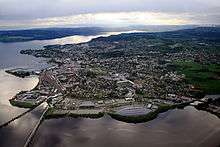 mid-June 2009 aerial photograph of Hamar | |
 Coat of arms  Innlandet within Norway | |
 Hamar within Innlandet | |
| Coordinates: 60°47′57″N 11°3′22″E | |
| Country | Norway |
| County | Innlandet |
| Municipality ID | NO-3403 |
| Administrative centre | Hamar |
| Government | |
| • Mayor (2015) | Einar Busterud |
| Area (Nr. 257 in Norway) | |
| • Total | 350.94 km2 (135.50 sq mi) |
| • Land | 338 km2 (131 sq mi) |
| Elevation | 150 m (490 ft) |
| Population (2017) | |
| • Total | 30,598 |
| • Density | 87/km2 (230/sq mi) |
| • Change (10 years) | 4.3% |
| • Rank in Norway | 30 |
| Time zone | UTC+1 (CET) |
| • Summer (DST) | UTC+2 (CEST) |
| Postal code | 2300 to 2319 |
| Area code(s) | (+47) 62 |
| Official language form | Neutral |
| Demonym | Hamarenser/Hamarensar Hamarsing[1] |
| Climate | Dfc |
| Website | www |
The town is located on the shores of Mjøsa, Norway's largest lake, and is the principal city of Hedmark county. It is bordered to the northwest by the municipality of Ringsaker, to the north by Åmot, to the east by Løten, and to the south by Stange.
General information
Name
The municipality (originally the town) is named after the old Hamar farm (Old Norse: Hamarr); the medieval town was built on its ground. The name is identical with the word hamarr which means "rocky hill".
Coat-of-arms
The coat-of-arms shows a Black Grouse sitting in the top of a pine tree on a white background. It was first described in the anonymous Hamar Chronicle, written in 1553.
History
Between 500 and 1000 AD, Aker farm was one of the most important power centres in Norway, located just a few kilometres away from today's Hamar. Three coins found in Ringerike in 1895 have been dated to the time of Harald Hardråde and are inscribed Olafr a Hamri.
Middle Ages
At some point, presumably after 1030 but clearly before 1152, the centre was moved from Aker to the peninsula near Rosenlundvika, what we today know as Domkirkeodden. There are some indications Harald Hardråde initiated this move because he had property at the new site.
Much of the information about medieval Hamar is derived from the Hamar Chronicles, dated to about 1550. The town is said to have reached its apex in the early 14th century, dominated by the Hamar cathedral, bishop's manor, and fortress, and surrounding urbanization. The town was known for its fragrant apple orchards, but there were also merchants, craftsmen, and fishermen in the town.
After the Christianization of Norway in 1030, Hamar began to gain influence as a centre for trade and religion, until the episcopal representative Nikolaus Breakspear in 1152 founded Hamar Kaupangen as one of five dioceses in medieval Norway. This diocese included Hedemarken and Christians Amt, being separated in 1152 from the former diocese of Oslo. The first bishop of Hamar was Arnold, Bishop of Gardar, Greenland (1124–1152). He began to build the now ruined cathedral of Christ Church, which was completed about the time of Bishop Paul (1232–1252). Bishop Thorfinn (1278–1282) was exiled and died at Ter Doest abbey in Flanders, and was later canonised. Bishop Jörund (1285–1286) was transferred to Trondheim. A provincial council was held in 1380. Hamar remained an important religious and political centre in Norway, organized around the cathedral and the bishop's manor until the Reformation 1536-1537, when it lost its status as a bishopric after the last Catholic bishop, Mogens Lauritssøn (1513–1537), was taken prisoner in his castle at Hamar by Truid Ulfstand, a Danish noble, and sent to Antvorskov in Denmark, where he was mildly treated until his death in 1542. There were at Hamar a cathedral chapter with ten canons, a school, a Dominican Priory of St. Olaf, and a monastery of the Canons Regular of St. Anthony of Vienne.[2]
Hamar, like most of Norway, was severely diminished by the Black Plague in 1349, and by all accounts continued this decline until the Reformation, after which it disappeared.
The Reformation in Norway took less than 10 years to complete, from 1526 to 1536. The fortress was made into the residence of the sheriff and renamed Hamarhus fortress. The cathedral was still used but fell into disrepair culminating with the Swedish army's siege and attempted demolition in 1567, during the Northern Seven Years' War, when the manor was also devastated.
Reformation and decline
By 1587, merchants in Oslo had succeeded in moving all of Hamar's market activities to Oslo. Though some regional and seasonal trade persisted into the 17th century, Hamar as a town ceased to exist by then. In its place, the area was used for agriculture under the farm of Storhamar, though the ruins of the cathedral, fortress, and lesser buildings became landmarks for centuries since then.
The King made Hamarhus a feudal seat until 1649, when Frederick III transferred the property known as Hammer to Hannibal Sehested, making it private property. In 1716, the estate was sold to Jens Grønbech (1666–1734). With this, a series of construction projects started, and the farm became known as Storhamar, passing through several owners until Norwegian nobility was abolished in 1831, when Erik Anker took over the farm.[3]
The founding of modern Hamar

As early as 1755, the Danish government in Copenhagen expressed an interest in establishing a trading center on Mjøsa. Elverum was considered a frontier town with frequent unrest, and there was even talk of encouraging the dissenting Hans Nielsen Hauge to settle in the area. Bishop Fredrik Julius Bech, one of the most prominent officials of his time, proposed establishing a town at or near Storhamar, at the foot of Furuberget.
In 1812, negotiations started in earnest, when the regional governor of Kristians Amt, proposed establishing a market on Mjøsa. A four-person commission was named on 26 July 1814, with the mandate of determining a suitable site for a new town along the shore. On 8 June 1815, the commission recommended establishing such a town at Lillehammer, then also a farm, part of Fåberg.
Acting on objections to this recommendation, the department of the interior asked two professors, Ludvig Stoud Platou and Gregers Fougner Lundh, to survey the area and develop an alternative recommendation. It appears that Lundh in particular put great effort into this assignment, and in 1824 he presented to the Storting a lengthy report, that included maps and plans for the new town.
Lundh's premise was that the national economic interest reigned supreme, so he based his recommendation on the proposed town's ability to quickly achieve self-sustaining growth. He proposed that the name of the new town be called Carlshammer and proposed it be built along the shore just north of Storhamar and eastward. His plans were detailed, calling for streets 20 meters broad, rectangular blocks with 12 buildings in each, 2 meters separating each of them. He also proposed tax relief for 20 years for the town's first residents, that the state relinquish property taxes in favor of the city, and that the city be given monopoly rights to certain trade. He even proposed that certain types of foreigners be allowed to settle in the town to promote trade, in particular, the Quakers.
His recommendation was accepted in principle by the government, but the parliamentary committee equivocated on the location. It left the determination of the actual site to the king so as to not slow down things further. Another commission was named in June 1825, consisting of Herman Wedel-Jarlsberg, professor Lundh, and other prominent Norwegians. After surveying the entire lake, it submitted another report that considered eleven different locations, including sites near today's Eidsvoll, Minnesund, Tangen in Stange, Aker, Storhamar, Brumunddal, Nes, Moelven, Lillehammer, Gjøvik, and Toten. Each was presented with pros and cons. The commission itself was split between Lillehammer and Storhamar. The parliament finally decided on Lillehammer, relegating Hamar once more, it seemed, to be a sleepy agricultural area.
As steamboats were introduced on the lake, the urban elite developed an interest in the medieval Hamar, and in 1841, editorials appeared advocating the reestablishment of a town at Storhamar. By then the limitations of Lillehammer's location had also become apparent, in particular those of its shallow harbor. After a few more years of discussions and negotiations both regionally and nationally, member of parliament Frederik Stang put on the table once more the possibility of a town in or near Storhamar. The governor at the time, Frederik Hartvig Johan Heidmann, presented a thorough deliberation of possible specific locations, and ended up proposing the current site, at Gammelhusbukten.
On 26 April 1848, the king signed into law the establishment of Hamar on the grounds of the farms of Storhamar and Holset, along the shores of Mjøsa. The law stated that the town will be founded on the date its borders are settled, which turned out to be 21 March 1849, known as the merchant town of Hamar, with a trading zone within five kilometers (3.1 miles) of its borders.[3]
Building a city
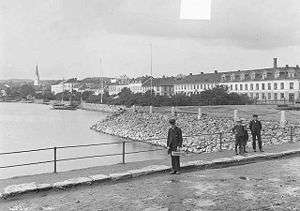
The area of the new town covered 400 mål which is the equivalent to today's 40 hectares (99 acres) (40 hectare). An army engineer, Røyem, drafted the initial plan. There would be three thoroughfares, at Strandgata, Torggata, and Grønnegate (the latter the name of a medieval road) and a grid system of streets between them. The orientation of the town was toward the shore. Røyem set aside space for three parks and a public square, and also room for a church just outside the town's borders.
There were critics of the plan, pointing out that the terrain was hilly and not suitable for the proposed rigid grid. Some adjustments were made, but the plan was largely accepted and is evident in today's Hamar. There were also lingering concerns about the town's vulnerability to flooding.
No sooner had the ink dried on the new law, and building started in the spring of 1849. The first buildings were much like sheds, but there was great enthusiasm, and by the end of 1849, ten buildings were insured in the new town. None of these are standing today; the last two were adjacent buildings on Skappelsgate. By 1850, there were 31 insured houses, and 1852, 42; and in 1853, 56. Building slowed down for a few years and then picked up again in 1858, and by the end of 1860 there were 100 insured houses in the town. The shore side properties were obliged to grow gardens, setting the stage for a leafy urban landscape.
Roads quickly became a challenge – in some places, it was necessary to ford creeks in the middle of town. The road inspector found himself under considerable stress, and it was not until 1869 street names were settled. Highways in and out of the city also caused considerable debate, especially when it came to financing their construction.
The first passenger terminal in Hamar was in fact a crag in the lake, from which travelers were rowed into the city. In 1850, another pier was built with a two-storey terminal building. All this was complicated by the significant seasonal variations in water levels. In 1857 a canal was built around a basin that would allow freight ships to access a large warehouse. Although the canal and basin still were not deep enough to accommodate passenger steamships, the area became one of the busiest areas in the town and the point around which the harbor was further developed.[4]
The Diocese of Hamar was established in 1864, and the Hamar Cathedral was consecrated in 1866 and remains a central point in the city.
A promenade came into being from the harbor area, past the gardens on the shore, and north toward the site of the old town.
Establishment of government

The first executive of Hamar was Johannes Bay, who arrived in October 1849 to facilitate an election of a board of supervisors and representatives. The town's Royal Charter called for the election of 3 supervisors and 9 representatives, and elections were announced in the paper and through town crier. Of the 10 eligible town citizens, three supervisors were elected, and the remaining six were elected by consent to be representatives, resulting in a shortfall of 3 on the board. The first mayor of Hamar was Christian Borchgrevink.
The first order of business was the allocation of liquor licenses and the upper limit of alcohol that could be sold within the town limits. The board quickly decided to award licenses to both applicants and set the upper limit to 12,000 "pots" of liquor, an amount that was for all intents and purposes limitless.
The electorate increased in 1849 to 26, including merchants and various craftsmen, and the empty representative posts were filled in November. In 1850, the board allowed for unlimited exercise of any craft for which no citizenship had been taken out, which led to much unregulated craftsmanship. Part-time policemen were hired, and the town started setting taxes and a budget by the end of 1849. In 1850, a new election was held for the town board.
The painter Jakobsen had early on offered his house for public meetings and assembly, and upon buying a set of solid locks, his basement also became the town prison. One merchant was designated as the town's firefighter and was given two buckets with equipment, and later a simple hose, but by 1852 a full-time fire chief was named. There was also some controversy around the watchman who loudly reported the time to all the town's inhabitants every half-hour, every night. Hamar also had a scrupulously enforced ordinance against smoking (pipe) without a lid in public or private.
In Hamar's early days, the entire population consisted of young entrepreneurs, and little was needed in the way of social services. After a few years, a small number of indigent people needed support, and a poorhouse was erected.[4]
Fires, floods and other disasters
In 1878, as the firefighting capabilities of the young town were upgraded, a fire broke out in a bakery that was put out without doing too much damage. In February 1879 at 2:00 in the morning another fire broke out after festivities, burning down an entire building that housed many historical items from town's history. This was followed by a series of fires that left entire blocks in ashes that seemed to come to an end in 1881, when a professional fire corps was hired.
In 1860, concerns about flooding were vindicated when a late and sudden spring caused the lake to flood, peaking on about 24 June, when the street-level floor of the front properties was completely inundated. This was the worst flood recorded since 1789. By 9 July, the floods had receded. But it was not to prove the end of the calamities. In August, massive rainfall led to flash flooding in the area, putting several streets under water. This was immediately followed by unseasonably cold weather, freezing the potato crops and inconveniencing Hamar's residents. And then, mild weather melted all the ice and accumulated snow, leading to another round of flooding. By the time a particularly cold and snow-filled winter set in, there was mostly relief about getting some stability.
In 1876, the town was scandalized by the apprehension of one Kristoffer Svartbækken, arrested for the cold-blooded murder of 19-year-old Even Nilsen Dæhlin. Svartbækken was convicted for the murder and executed the year after in the neighboring rural community of Løten in what must have been a spectacle with an audience of 3,000 locals, presumably most of Hamar's population at the time.
Then in 1889, there were riots in Hamar over the arrest of one of their own constables, one sergeant Huse, who had been insubordinate while on a military drill at the cavalry camp at Gardermoen. In an act of poor judgment, Huse's superior sent him to Hamar's prison in place of military stockades. Partly led and partly tolerated by other constables, the town's population engaged in demonstrations, marches, and other unlawful but non-violent acts that were effectively ended when a company of soldiers arrived from the camp at Terningmoen near Elverum.[4]
Cityscape

The Hedmark museum, located on Domkirkeodden, is an important historical landmark in Hamar, an outdoor museum with remains of the medieval church, in a protective glass housing, the episcopal fortress and a collection of old farm houses. The institution is a combined medieval, ethnological and archaeological museum, and has received architectural prizes for its approach to conservation and exhibition. It also houses a vast photographic archive for the Hedmark region.
Additionally, Hamar is known for its indoor long track speed skating and bandy arena, the Olympia Hall, better known as Vikingskipet ("The Viking ship") for its shape. It was built to host the speed skating competitions of the 1994 Winter Olympics that were held in nearby Lillehammer. Already in 1993 it hosted the Bandy World Championship. The Vikingskipet Olympic Arena was later used in the winter of 2007 as the service park for Rally Norway, the second round of the 2007 World Rally Championship season. It has been the host for the world's second largest computer party The Gathering starting on the Wednesday in Easter each year, for the last 13 years.
Also situated in Hamar is the Hamar Olympic Amphitheatre which hosted the figure skating and short track speed skating events of the 1994 Winter Olympics. The figure skating competition was highly anticipated. It featured Nancy Kerrigan and Tonya Harding, who drew most of the media attention, however the gold medal was won by Oksana Baiul of Ukraine.
The centre of Hamar is the pedestrian walkway in the middle of town, with the library, cinema and farmer's market on Stortorget (the big square) on the western side, and Østre Torg (the eastern square), which sits on top of an underground multi-story carpark, on the eastern side.
Transport
Hamar is an important railway junction between two different lines to Trondheim. Rørosbanen, the old railway line, branches off from the mainline Dovre Line. The Norwegian Railway Museum (Norsk Jernbanemuseum) is also in Hamar. Hamar Airport, Stafsberg caters to general aviation.
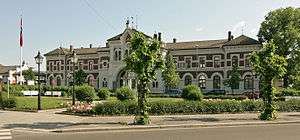
Notable residents
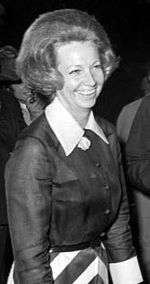
- Anders Baasmo Christiansen, actor (b. 1976)
- Rut Brandt, writer, second wife of Willy Brandt (1920–1986)
- Irene Dalby, former top swimmer (b. 1971)
- Egil Danielsen, Olympic gold medalist, javelin (1933-2019)
- Rikka Deinboll, librarian and translator (1897–1973)
- Sigurd Evensmo, author (1912–1978)
- Knut Faldbakken, writer (b. 1941)
- Kirsten Flagstad, opera singer (1895–1962)
- Hulda Garborg, writer (1862–1934)
- Rolf Jacobsen, Poet (1907–1994)
- Olaf Johannessen, shooter (1890–1977)
- Øivind Bergh, Norwegian violinist and orchestral leader (1909-1987)
- Erik Kristiansen, former ice hockey player (b. 1963)
- Terje Kojedal, former professional footballer (b. 1957)
- Torill Kove, award-winning animator (b. 1958)
- Katti Anker Møller, civil rights activist (1868–1945)
- Vegard Skogheim, former professional footballer (b. 1966)
- Patrick Thoresen, professional ice hockey player (b. 1983)
- Anette Trettebergstuen, politician (b. 1981)
- Petter Vaagan Moen, footballer (b. 1984)
- Even Wetten, former speed skater (b. 1982)
- Ole Edvard Antonsen, trumpet player (b. 1962)
- Thorstein Helstad, footballer
- Marcus Pedersen, footballer
- Ole Børud, singer, song-writer, and instrumentalist (b. 1976)
Sports

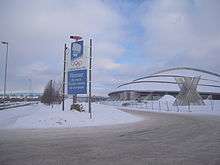
Team sports
Hamar boasts several teams at the Norwegian top level in various sports:
- Hamarkameratene (Ham-Kam) is a football (soccer) team that plays in the Adeccoligaen after being relegated from the Tippeligaen in 2008.
- Storhamar Ishockey is an ice hockey team which is currently playing in the Norwegian GET-ligaen. The club has won the title a total of seven times, latest season 2017/18.
- Storhamar HE is a handball team that plays in Eliteserien.
- Fart IL is a women's football team currently playing its first season in the top league.
- Hamar Idrettslag has played in the highest bandy division recently, but this season, 2009–2010, they play in the 2nd.
Individual sports
Hamar is known for its speed skating history, both for its skaters and the championships that have been hosted by the city, already in 1894 Hamar hosted its first European championship, and the first World Championship the following year. After the Vikingskipet was built, Hamar has hosted international championships on a regular basis.
The most notable skaters from Hamar are Dag Fornæss and Even Wetten, both former World champions, allround and 1000m respectively. Amund Sjøbrend, Ådne Sønderål and Eskil Ervik have all been members of the local club Hamar IL, although they were not born in Hamar.
In Hamar on 17 July 1993, Scottish cyclist Graeme Obree set a world record for the distance covered in an hour. His 51,596 metres broke the 51,151 set at altitude nine years earlier but lasted only six days before Chris Boardman broke it in Bordeaux.
Other notable athletes:
Events
Hamar was the venue of three sports during the 1994 Winter Olympics, figure skating, short track and speed skating.
International relations
Twin towns – Sister cities
The following cities, both in Scandinavia and around the world, are twinned with Hamar:[5]








In literature
Part of the plot of "The Axe", the first volume of Sigrid Undset's "The Master of Hestviken", is set in the Medieval Hamar. The book's young lovers, denied the right to marry by malicious relatives, come to the town in order to try to get the help of the kindly and compassionate Bishop Thorfinn of Hamar.
References
- "Personnemningar til stadnamn i Noreg" (in Norwegian). Språkrådet. Archived from the original on 25 June 2009. Retrieved 25 June 2009.
-

- Ramseth, Christian (1991). Hamar bys historie: til 50 års jubilæet 21 mars 1899 (in Norwegian). Hamar Historical Society.
- Pedersen, Ragnar (1990). Den adelige frie sedegård Storhamar (Fra Kaupang og Bygd) (in Norwegian). Hedmarksmuseet og Domkirkeodden. ISBN 82-990752-7-0.
- "Vennskapsbyer" (in Norwegian). Hamar kommune. Archived from the original on 24 December 2008. Retrieved 22 December 2008.
External links
| Wikimedia Commons has media related to Hamar. |
| Look up Hamar in Wiktionary, the free dictionary. |
- Municipal fact sheet from Statistics Norway

- Hamar Pictorial click-through
- The Hedmark Museum (in Norwegian) (Translate to English: Google, Bing)
- Kirsten Flagstad Museum (in Norwegian) (Translate to English: Google, Bing)
- The Norwegian national railway museum (in Norwegian) (Translate to English: Google, Bing)
- The Viking Ship (in Norwegian) (Translate to English: Google, Bing)


